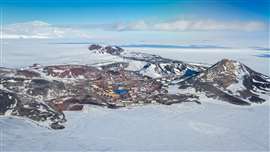Read this article in 中文 Français Deutsch Italiano Português Español
5 major global science facility builds running behind schedule
13 June 2024
The US National Science Foundation (NSF) – an independent agency of the US government that support research and education programmes in the science and engineering fields – reported to the US Government Accountability Office (GAO) that five major global science facility construction projects are likely to go over-schedule.
 Aerial view of McMurdo Station, Antarctica, the most populated region on the continent. (Image: Adobe Stock)
Aerial view of McMurdo Station, Antarctica, the most populated region on the continent. (Image: Adobe Stock)
NSF said its data and research showed the construction of Vera C. Rubin Observatory in Chile, the Regional Class Research Vessels (RCRV) project in the US, the Antarctic Infrastructure Modernization for Science (AIMS) project at McMurdo Station, and both Large Hardon Collider (LHC) High Luminosity Upgrade projects – located near Geneva on the French/Swiss border – are likely to endure “increased schedules”.
What’s causing delays to NSF projects?
The issues hampering the schedules vary by project, which are scattered across the planet, but have some overlapping issues.
“Specifically, both RCRV and AIMS have reported staffing shortages, each with unique causes, that are resulting in ongoing construction delays,” said NSF. “A shortage of skilled labour is an issue for the entire shipbuilding industry, particularly in Louisiana, home of the RCRV shipyard.”
The report also noted that the shipyard missed the scheduled delivery date (22 September, 2023) for the first of two vessels to be built as part of the project.
“The awardee is withholding financial penalties in accordance with the shipyard contract,” added NSF.
AIMS’ remote location on the world’s least-populated continent, coupled with a tight skills market in the industry, led to elongated plans.
NSF added that construction of a vehicle equipment and operation centre and a lodging facility at McMurdo Station are likely to be pushed back at last one year “due to construction errors and availability of materials.”
 The Vera C. Rubin Observatory in Chile currently under construction. (Image: Rubin Observatory)
The Vera C. Rubin Observatory in Chile currently under construction. (Image: Rubin Observatory)
“The lower availability of domestic labour has increased reliance on non-American workers, and the process for obtaining background checks for these workers is taking longer than the expected four-week period,” added NSF.
At Rubin Observatory, a vacuum leak caused a ‘multi-month delay’ in the shipment of a camera, while a malfunctioning dome crane also led to setbacks.
Are NSF projects overbudget?
All but one of the five major projects is on-pace or underneath its expected budget at this junction.
NSF has requested additional funding as needed, the most for the Rubin Observatory. The agency said the expected US$571 million cost is nearly $100 million over the initial authorisation and more than $81 million more than the adjusted 2024 projection. It is forecasted to be 31 months behind, with a completion date now scheduled for 2025.
The RSRV project is 30 months behind and $35 million overbudget, with a total value now at $400 million. Completion is expected in 2027.
The pair of detector builds in the LHC upgrade projects are $17.8 billion overbudget, with the toroidal apparatus construction behind 26 months and the compact muon solenoid device construction delayed 22 months. The two units are now expected to be constructed by mid-2028 and cost .
 Render schematic of the major upgrades to the ATLAS detector. (Image: ATLAS Collaboration/CERN)
Render schematic of the major upgrades to the ATLAS detector. (Image: ATLAS Collaboration/CERN)
The only project to come in at, or below, authorised budget and under-time was AIMS, which is now estimated to cost $135 million less and finish 15 months earlier than projected in 2027.
However, the NSF will reassess the projects next month, and more delays could be announced at AIMS based on labour access restrictions and the delays to the lodging and storage units.
About the Vera C. Rubin Observatory
The NSF Rubin Observatory is a planned facility for an 8.4m wide-field optical telescope, which will photograph the southern sky every three days for one decade with the ‘world’s largest’ digital camera (three billion pixels).
About the Regional Class Research Vessels projects
The RCRV project is building three ships that scientists will use to conduct research of the US coasts
About the Antarctic Infrastructure Modernization for Science project
The AIMS project seeks to modernise Antarctica’s McMurdo Station, including updated storage and lodging facilities.
About the Large Hardon Collider High Luminosity Upgrade projects
The project is installing two general detectors – a toroidal LHC apparatus (ATLAS) and a compact muon solenoid (CMS) – for the European Organization for Nuclear Research. They will investigate a wide range of physics, including particles that could make up dark matter.
STAY CONNECTED


Receive the information you need when you need it through our world-leading magazines, newsletters and daily briefings.
CONNECT WITH THE TEAM











